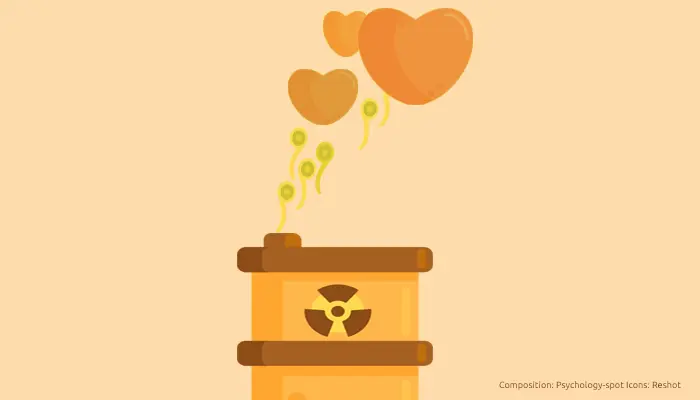
If a relationship hurts us and it is not possible to change those dysfunctional patterns, the most sensible thing to do is to end it. However, this is often easier said than done. There are people who get trapped in a harmful relationship and cannot get out of its network. Why is it so difficult to get out of a toxic relationship?
There are a thousand and one reasons to cling to a toxic relationship, from fear of being alone to reluctance to start over. However, all these reasons are subject to one fact: the level of satisfaction that the relationship brings.
Although it may seem strange to mix the words “satisfaction” and “toxic partner” in the same sentence, the truth is that all the relationships we establish must satisfy at least some of our needs.
When a relationship stops completely satisfying our needs, we simply no longer have the incentive to continue investing in it, so we do not experience the emotional ambivalence that binds us and the breakup is inevitable. However, toxic relationships usually have an “addictive” component that keeps us trapped in their web.
The addictive component of toxic relationships
No matter how harmful or toxic a relationship may be, it is not usually completely negative because in that case it would be much easier to cut the ties. Even if the relationship goes bad, it is not always like that. There are also “good” days or periods.
The person who normally appears distant or even aggressive can also appear affectionate and considerate, generating moments of serenity and joy in the midst of the storm. This makes the other member of the couple excited, convincing themselves that it was just a “bad streak” or that everything can really change.
These emotional ups and downs are particularly intense in toxic relationships and act on the brain almost like a drug. When the relationship is going well, it generates very positive experiences that serve as rewards, making it extremely difficult for the abused person to give up those almost “happy” moments.
Although it may seem paradoxical, people can cling more tightly to a toxic relationship than to one that has simply worn out over time, because it puts them on an emotional roller coaster. In Psychology, this phenomenon responds to a variable reinforcement program.
In practice, the frequency with which we receive the reward (affection, attention…) influences our decisions and behaviors. When the frequency is variable, it means that the reward is unpredictable, so we cannot know when we will receive it. However, we hope to receive it at some point – and that is usually motivating enough.
In fact, research has shown that variable reinforcement schedules lead to very persistent attempts to obtain the reward because we wait for the next attempt to bear fruit. A study conducted at Harvard University, for example, revealed that variable reinforcement can make us 2.5 to 3 times more perseverant. How is it possible?
We think that one last attempt could lead to the long-awaited prize, so we remain tied to that illusion. Pending the next positive experience, we do not think clearly because our frontal lobes practically “disconnect”, as happens in addictions.
The same thing happens in a relationship: we convince ourselves that if we wait a little longer, that person could change and everything would be better. We convince ourselves that the next good period will be the definitive one. This pattern helps explain why it is so difficult to get out of a toxic relationship.
When bad times reinforce good times
Curiously, the inconsistent reinforcement pattern established in toxic relationships is precisely one of the incentives to keep people trapped in that web. The bad times make the good times seem better. It’s like when we drink water when we’re very thirsty.
In a bad relationship, good times provide a double reward because they not only bring something positive, but also erase the negative. The person may feel so relieved to be treated well, to receive attention and affection, that the reward centers of the brain receive more intense stimulation.
Unfortunately, this reinforces the toxic cycle, another phenomenon known as negative reinforcement. In fact, eliminating aversive feelings increases the likelihood that a behavior will be repeated, much more than a simple positive reward. In practice, the sense of release and comfort we may experience, even momentarily, further reinforces the unhealthy relationship.
Each negative experience maximizes the next positive experience, making it more special and exciting. That way, each cycle of psychological rewards and good times makes it harder to get out of a toxic relationship.
How to break that cycle and end the relationship?
To get out of a toxic relationship, the first step is to recognize the existence of that “addictive” pattern. It is necessary to identify what keeps us tied and understand that these false hopes prevent us from seeing the warning signs clearly.
The search for those moments of reward in the form of affection and attention boils down to waiting for crumbs that cannot really satisfy our need for love, stability and commitment. Recognizing that will help us develop a more balanced view of what is happening, to realize that we need to put an end to it.
Likewise, it is important that we keep active in our minds the reasons why it is better to end the relationship. And make sure to put up obstacles that prevent us from “backsliding,” such as deleting his/her contact information to prevent us from making impulsive decisions in a moment of vulnerability that we will later regret.
Finally, we have to be careful with false hopes that lead us to believe that this time everything will be different because often it is just an attempt of rationalization to return to that toxic relationship.
References:
Gillihan, S. J. (2023) Why It Can Be So Hard to End Even a Bad Relationship. In: PsychologyToday.
Staddon, J. E. & Cerutti, D. T. (2003) Operant Conditioning. Annual Review of Psychology; 54: 115-144.
Zuriff, G. E. (1970) A comparison of variable-ratio and variable-interval schedules of reinforcement. J Exp Anal Behav; 13(3): 369–374.



